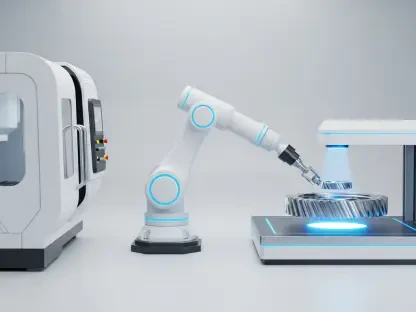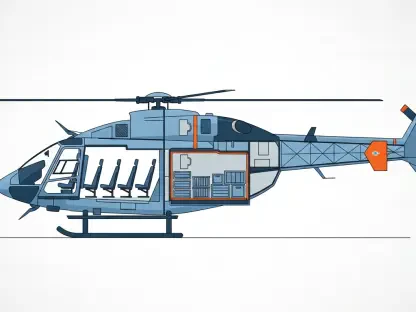Atlas Copco’s recent shift to polymer-based additive manufacturing (AM) has revolutionized its production processes, showcasing dramatic improvements in cost efficiency, lead times, and environmental sustainability. Leveraging advanced EOS technology, this transformation aligns with broader industry trends towards more sustainable and efficient manufacturing practices.
Cost and Efficiency Gains
Significant Reduction in Production Costs
Atlas Copco’s move to in-house polymer-based AM has generated remarkable cost savings. The company reports a 30% decrease in production costs, largely due to the efficiency and precision of the EOS P 396 3D printer. This machine minimizes material wastage, driving down costs and enhancing economic efficiency. The transition has also reduced dependence on third-party suppliers, cutting various outsourcing expenses that previously inflated production costs. By assuming control over its manufacturing processes, Atlas Copco has demonstrated how internalizing production capabilities can lead to considerable operational gains.
The EOS P 396’s ability to optimize the use of materials has been pivotal. This advanced 3D printer employs state-of-the-art technology to ensure minimal excess material is produced, significantly curbing waste. This not only saves on material costs but also aligns with the company’s broader sustainability goals. Moreover, the reduced dependency on external suppliers has shielded Atlas Copco from the fluctuating costs and reliability issues associated with third-party sourcing. Streamlining production internally has rendered a leaner, more cost-effective manufacturing process, setting a new standard for efficiency in the industry.
Drastic Cut in Lead Times
The adoption of AM technology has revolutionized lead times, trimming them from 6-12 weeks to just 3-4 days. This rapid turnaround is achievable because in-house 3D printing simplifies the supply chain, allowing for immediate production upon demand. This not only speeds up the entire manufacturing process but also ensures that Atlas Copco can respond swiftly to market needs and customer demands without long delays. The agility afforded by in-house AM has thus positioned the company to better compete in a fast-paced market environment.
In traditional manufacturing, the dependence on external suppliers for components often introduces significant delays. However, with the integration of the EOS P 396, Atlas Copco has taken full control over its production schedule. The ability to produce components on-demand eliminates the waiting period associated with order placements and deliveries from third-party vendors. This immediate availability of parts streamlines the entire production process, enabling the company to fulfill orders with remarkable speed. Such efficiency directly translates into enhanced customer satisfaction and the ability to seize market opportunities more promptly.
Enhanced Operational Efficiency
By integrating AM technology into its production workflow, Atlas Copco has achieved a leaner and more agile manufacturing process. The precision of the EOS P 396 reduces waste to near zero, a significant improvement from the prior wastage rate of 7%. This efficiency aligns with the company’s goal to streamline operations and enhance overall productivity while maintaining high quality standards. The precision and reliability of additive manufacturing foster consistency in product quality, which is crucial for maintaining the company’s reputation for excellence.
Operationally, the adoption of AM technology has simplified several complex processes. Tasks that once required multiple stages and coordination with various suppliers can now be accomplished in a single, streamlined production cycle. This integration of AM has also freed up resources, allowing the workforce to focus on innovation and improvement rather than logistical challenges. The reliability and repeatability of the EOS P 396 have ensured that each part is produced to exact specifications, maintaining uniformity across the board. As a result, Atlas Copco can consistently deliver high-quality products while significantly reducing the time and resources traditionally required.
Environmental Impact
Sustainable Manufacturing Practices
Atlas Copco’s in-house AM production has led to a reduced environmental footprint. The precise nature of the EOS P 396 printer cuts down on excess material usage, minimizing waste and therefore contributing to more sustainable manufacturing processes. This aligns with global trends advocating for reduced environmental impact in industrial operations. A significant reduction in material waste not only helps in conserving resources but also reduces the energy required for production, further decreasing the overall environmental impact of manufacturing activities.
The shift towards in-house AM also emphasizes the company’s commitment to sustainable practices. By opting for more efficient production methods, Atlas Copco is setting an example for the industry on how technological advancements can be leveraged to achieve environmental goals. The reduced waste generation mirrors a move towards a circular economy, where resources are used more efficiently and kept in use for as long as possible. This sustainable approach benefits not only the environment but also the company’s bottom line by reducing material costs and waste disposal expenses.
Reduction in Transport Resources
By localizing production through polymer-based AM, Atlas Copco has significantly lowered its reliance on transport resources. The need to ship components from external suppliers has been drastically reduced, cutting down on the carbon emissions associated with transportation. This shift underscores Atlas Copco’s commitment to environmental responsibility and highlights the broader benefits of adopting in-house AM technologies. Reducing the need for long-distance transportation also decreases the energy consumption related to logistics, aligning with the global push for more eco-friendly manufacturing practices.
The localization of production also brings about logistical advantages. By minimizing the need for transportation, Atlas Copco can drastically cut down on lead times associated with shipping, customs, and other logistical challenges. This ability to produce components close to the point of use translates into faster production cycles and a more responsive supply chain. Additionally, the reduction in transportation needs lessens the environmental burden caused by vehicle emissions, contributing to cleaner air and less polluted environments. Such measures highlight the dual benefits of localized production: operational efficiency and environmental stewardship.
Technological Adoption and ROI
Role of EOS Technology
The successful integration of EOS technology, particularly the EOS P 396 3D printer, signifies a milestone in Atlas Copco’s manufacturing journey. This advanced printer supports 14 materials and 26 parameter sets, offering versatility and precision. The company’s use of DyeMansion DM60 for coloring solutions, facilitated by EOS partnerships, further underscores the comprehensive ecosystem supporting AM technology. The synergy between these technologies has enabled Atlas Copco to maintain high standards while exploring new avenues in product customization and innovation.
EOS technology’s versatility is a significant factor in its successful adoption. The ability to work with multiple materials and parameter sets allows for a wide range of applications, catering to various production needs. This flexibility is crucial for a company like Atlas Copco, which produces a diverse portfolio of products. Additionally, the collaboration with DyeMansion for coloring solutions has expanded the aesthetic possibilities for the company’s products, allowing for more personalized and customer-specific designs. This integration of technology showcases how advanced manufacturing can meet both functional and creative needs.
Achieving Return on Investment
Atlas Copco’s investment in AM technology proved financially viable, achieving a significant return on investment (ROI) within 18 months. This rapid ROI highlights the financial benefits of embracing advanced manufacturing technologies and supports the notion that such investments can lead to substantial long-term gains. The ability to recoup the initial investment quickly is indicative of the cost-efficiency and economic viability of polymer-based AM, making it a compelling option for modern manufacturers.
The quick ROI can be attributed to several factors, including the substantial reduction in production costs and lead times. By saving on materials, decreasing waste, and minimizing the dependency on external suppliers, Atlas Copco has streamlined its cost structure significantly. Furthermore, the enhanced production capabilities and rapid lead times have enabled the company to meet market demands more efficiently, translating to quicker revenue generation. These financial gains not only justify the initial investment but also provide a solid foundation for future growth and innovation in manufacturing technologies.
Support from EOS and Additive Minds
Comprehensive Support Framework
The collaboration with EOS’s consulting division, Additive Minds, provided Atlas Copco with a robust support system crucial for transitioning to polymer-based AM. This partnership included detailed cost-per-part analysis, optimal powder selection, post-processing techniques, and extensive training programs. Such comprehensive support ensured a smooth and successful adoption of the new technology. The depth and breadth of this support extend beyond mere technical advice, encompassing strategic insights and practical training that empower Atlas Copco to leverage AM to its fullest potential.
Additive Minds’ expertise was instrumental in navigating the complexities of adopting new technology. Their guidance on cost-per-part analysis helped Atlas Copco understand and optimize the economic aspects of AM, ensuring that each component produced was cost-effective. Optimal powder selection and advice on post-processing techniques further refined the production process, enhancing the quality and durability of the final products. The extensive training programs equipped the workforce with the necessary skills and knowledge, fostering a culture of innovation and proficiency within the company.
Importance of Strong Partnerships
Strong partnerships, such as that between Atlas Copco and Additive Minds, are essential for facilitating significant manufacturing transitions. The trust and collaboration between the two entities exemplify how strategic alliances can enhance operational capabilities, streamline processes, and accelerate the adoption of new technologies. The symbiotic relationship between them underscores the importance of cooperation in achieving mutual goals and navigating the complexities of modern manufacturing.
The success of Atlas Copco’s transition to AM is a testament to the power of collaboration. By leveraging the expertise and resources of Additive Minds, Atlas Copco was able to implement advanced manufacturing technologies with confidence and precision. This partnership not only provided the necessary technical support but also fostered a sense of shared purpose and vision. The mutual trust and open communication channels facilitated a seamless integration of AM technology, paving the way for continued innovation and excellence in manufacturing practices.
Broader Trends in Polymer 3D Printing
Industry-Wide Adoption
Polymer 3D printing is gaining traction across various industries, lauded for its ability to cut costs, speed up production, and promote sustainability. Projects like POLYLINE illustrate the potential for large-scale automated AM production lines, integrating every aspect of the production chain from printing to post-processing and logistics. Such comprehensive automation showcases how polymer 3D printing is evolving from a prototype tool to a robust solution for full-scale manufacturing, capable of meeting the demands of modern industry.
The POLYLINE project, involving key industry players like BMW and EOS, exemplifies the collaborative efforts driving the adoption of polymer 3D printing. By automating the entire production process, these projects demonstrate the feasibility and efficiency of AM in mainstream manufacturing. This paradigm shift is not just about technological capability but also about rethinking traditional manufacturing norms. The streamlined processes and reduced lead times enabled by automated AM production lines reflect a new era of manufacturing agility, where speed and efficiency are paramount.
Research and Innovation
Atlas Copco’s recent adoption of polymer-based additive manufacturing (AM) has significantly transformed its production methods, leading to notable advancements in cost-effectiveness, reduction in lead times, and enhanced environmental sustainability. This shift leverages cutting-edge EOS technology to streamline and improve the manufacturing process. The newfound efficiency and lowered costs mark substantial progress for the company. The integration of polymer-based AM is not just a significant leap for Atlas Copco but is also emblematic of a larger movement within the manufacturing sector towards greener, more efficient, and sustainable practices. By implementing these advanced technologies, Atlas Copco aims to stay at the forefront of innovation while reducing its environmental footprint. They are not only improving their products but also contributing positively to their industry’s future. This forward-thinking approach illustrates a broader industry trend towards adopting new technologies to achieve both economic and environmental goals. Thus, Atlas Copco’s initiative reflects a growing recognition of the benefits of sustainable practices in manufacturing.









